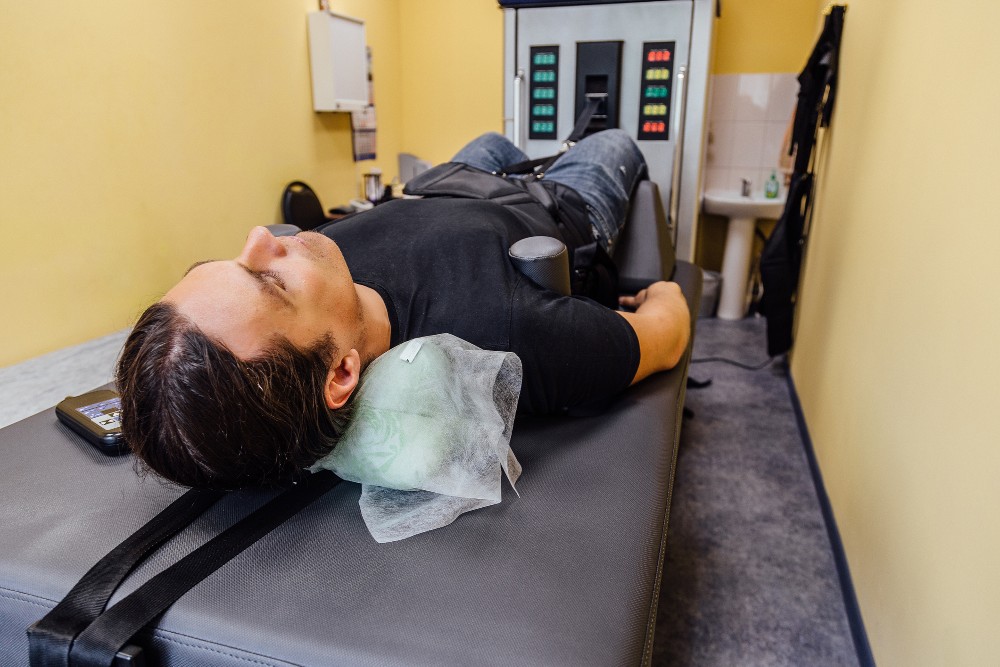Beating Winter Back Pain: Why Spinal Decompression Therapy is the Solution
As the winter months envelop us in their chilly embrace in Central Oregon, our daily routines often shift towards a more sedentary lifestyle. The combination of reduced physical activity and prolonged periods of sitting, often with less-than-ideal posture, can contribute to the onset or exacerbation of back pain. Understanding the factors that lead to this discomfort and exploring effective solutions, such as chiropractic care and spinal decompression therapy, can help you emerge into spring with renewed vitality and comfort.
Winter’s Impact on Back Health
Winter brings a unique set of challenges that can affect our musculoskeletal system, particularly the back. Several factors contribute to increased back pain during this season:
- Muscle Tightening Due to Cold Temperatures: Exposure to cold weather causes muscles, tendons, and ligaments to contract, leading to stiffness and reduced flexibility. This muscle tension can strain the spine, resulting in discomfort and pain.
- Decreased Physical Activity: Shorter days and colder weather often lead to a decline in outdoor activities. This reduction in movement can cause muscle weakening and joint stiffness, both of which contribute to chronic pain.
- Poor Posture from Indoor Activities: Spending more time indoors can lead to prolonged sitting, often with inadequate ergonomic support. Activities such as working from home or binge-watching television can encourage slouched or hunched postures, placing additional stress on the spine.
The Importance of Chiropractic Care
Our Bend chiropractors offer a holistic approach to managing and alleviating back and neck pain, especially during the winter months. Chiropractors are trained to diagnose and treat musculoskeletal issues, focusing on the spinal column‘s alignment to ensure optimal nervous system function. Here’s why consulting a chiropractor is beneficial:
- Personalized Treatment Plans: Chiropractors assess individual conditions to develop tailored treatment strategies that address the root cause of pain, rather than merely masking symptoms.
- Non-Invasive Techniques: Utilizing manual adjustments and other therapies, chiropractic care aims to restore proper spinal alignment and function without the need for spinal surgery or pain medication.
- Preventative Care: Regular chiropractic visits can help maintain spinal health, potentially preventing future episodes of back pain by addressing issues before they become severe.
Understanding Spinal Decompression Therapy

For individuals experiencing persistent or severe back pain, non-surgical spinal decompression emerges as a promising, non-surgical solution for pain relief. This therapy focuses on relieving pressure within the spinal discs, which can be particularly beneficial for conditions such as bulging discs and disc herniation, sciatica, and degenerative disc disease.
How Spinal Decompression Therapy Works
Spinal decompression treatment involves the use of a specialized motorized table that gently stretches and relaxes the spinal cord in a controlled manner. This process creates negative pressure within the spinal discs, encouraging retraction of bulging or herniated disc material and promoting blood flow and the influx of healing nutrients. The therapy aims to alleviate pressure on nerves and other spinal structures, thereby reducing pain and improving function.
What to Expect During Treatment
During a spinal decompression session, patients are comfortably positioned on the decompression table and secured with a harness. Our chiropractors in Bend customize the treatment parameters to address the specific condition and comfort level of the patient. Sessions typically last between 30 to 45 minutes, and a complete treatment plan may encompass multiple sessions over several weeks, depending on the severity of the condition.
Frequency of Chiropractic Visits
The recommended frequency of chiropractic visits varies based on individual needs and the nature of the back pain. For acute conditions, more frequent visits may be necessary initially, gradually tapering as significant improvement is observed. Chronic or maintenance care might involve regular visits spaced further apart to sustain spinal health and prevent recurrence. Collaborating with our chiropractors will help determine the most appropriate treatment schedule tailored to your specific needs.
Total Body Chiropractic in Bend, Oregon: Your Partner in Wellness

At Total Body Chiropractic in Bend, Oregon, we are committed to providing compassionate and effective care to help you overcome chronic back pain and enhance your quality of life. Our chiropractic team offers a range of services, including spinal decompression therapy, to address various musculoskeletal conditions.
Our Approach to Spinal Decompression Therapy
We utilize advanced equipment to perform spinal decompression therapy, ensuring a comfortable and personalized experience for each patient. Our therapy is designed to treat conditions such as chronic neck and back pain, bulging or herniated discs, degenerative disc disease, spinal stenosis, sciatica, and more. By focusing on relieving pressure within the spinal discs and promoting the natural healing process, we aim to provide long-term relief so you can return to normal activities.
Comprehensive Chiropractic Services
Beyond spinal decompression, Total Body Chiropractic offers a variety of non-surgical treatment options to support your health and well-being:
- Chiropractic Adjustments: Manual spinal adjustments to correct misalignments and restore proper function.
- Graston Technique: A specialized method to address soft tissue restrictions and promote healing.
- Shockwave Therapy: A non-invasive treatment that uses acoustic waves to stimulate tissue repair and reduce pain.
Embrace a Pain-Free Future
As winter gives way to the rejuvenating seasons of spring and summer, taking proactive steps to address lower back pain can significantly enhance your ability to enjoy outdoor activities and daily life. Whether you’re dealing with new discomfort or managing a chronic condition, our team at Total Body Chiropractic is here to support you on your journey to wellness.
Don’t let back pain hold you back. Contact us today to schedule a consultation at our Bend chiropractic office and discover how our comprehensive chiropractic services, including spinal decompression therapy, can help you achieve a pain-free and active lifestyle.
Frequently Asked Questions (FAQs) About Spinal Decompression Therapy
- What conditions can spinal decompression therapy help with? It is effective for treating herniated discs, sciatica, spinal stenosis, degenerative disc disease, and chronic back pain.
- Is spinal decompression therapy safe for everyone? While generally safe, it may not be suitable for individuals with fractures, severe osteoporosis, or spinal implants.
- How long does each session last? Each session typically lasts between 30 to 45 minutes.
- How many sessions will I need to see results? Most patients require multiple sessions over several weeks, with improvements often noticeable within the first few treatments.
- Will I feel pain during or after the treatment? The treatment is generally painless, but some patients may experience mild soreness as the body adjusts.
- How does spinal decompression differ from traditional chiropractic adjustments? Decompression therapy targets disc pressure relief, whereas adjustments focus on spinal alignment.
- Is spinal decompression therapy covered by insurance? Coverage varies, so it’s best to check with your insurance provider.
- Can spinal decompression therapy be combined with other treatments? Yes, it can complement chiropractic adjustments, physical therapy, and massage therapy.
- What should I expect after completing a full course of treatment? Many patients report significant pain relief and improved mobility.
- How can I maintain the benefits of spinal decompression therapy long-term? Regular exercise, proper posture, and periodic chiropractic visits can help sustain results.
















